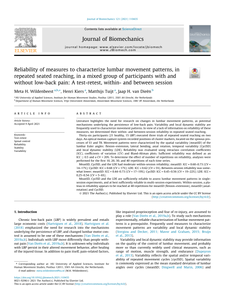Background: Development of more effective interventions for nonspecific chronic low back pain (LBP), requires a robust theoretical framework regarding mechanisms underlying the persistence of LBP. Altered movement patterns, possibly driven by pain-related cognitions, are assumed to drive pain persistence, but cogent evidence is missing. Aim: To assess variability and stability of lumbar movement patterns, during repetitive seated reaching, in people with and without LBP, and to investigate whether these movement characteristics are associated with painrelated cognitions. Methods: 60 participants were recruited, matched by age and sex (30 back-healthy and 30 with LBP). Mean age was 32.1 years (SD13.4). Mean Oswestry Disability Index-score in LBP-group was 15.7 (SD12.7). Pain-related cognitions were assessed by the ‘Pain Catastrophizing Scale’ (PCS), ‘Pain Anxiety Symptoms Scale’ (PASS) and the task-specific ‘Expected Back Strain’ scale(EBS). Participants performed a seated repetitive reaching movement (45 times), at self-selected speed. Lumbar movement patterns were assessed by an optical motion capture system recording positions of cluster markers, located on the spinous processes of S1 and T8. Movement patterns were characterized by the spatial variability (meanSD) of the lumbar Euler angles: flexion-extension, lateralbending, axial-rotation, temporal variability (CyclSD) and local dynamic stability (LDE). Differences in movement patterns, between people with and without LBP and with high and low levels of pain-related cognitions, were assessed with factorial MANOVA. Results: We found no main effect of LBP on variability and stability, but there was a significant interaction effect of group and EBS. In the LBP-group, participants with high levels of EBS, showed increased MeanSDlateral-bending (p = 0.004, η2 = 0.14), indicating a large effect. MeanSDaxial-rotation approached significance (p = 0.06). Significance: In people with LBP, spatial variability was predicted by the task-specific EBS, but not by the general measures of pain-related cognitions. These results suggest that a high level of EBS is a driver of increased spatial variability, in participants with LBP.
DOCUMENT

Literature highlights the need for research on changes in lumbar movement patterns, as potential mechanisms underlying the persistence of low-back pain. Variability and local dynamic stability are frequently used to characterize movement patterns. In view of a lack of information on reliability of these measures, we determined their within- and between-session reliability in repeated seated reaching. Thirty-six participants (21 healthy, 15 LBP) executed three trials of repeated seated reaching on two days. An optical motion capture system recorded positions of cluster markers, located on the spinous processes of S1 and T8. Movement patterns were characterized by the spatial variability (meanSD) of the lumbar Euler angles: flexion–extension, lateral bending, axial rotation, temporal variability (CyclSD) and local dynamic stability (LDE). Reliability was evaluated using intraclass correlation coefficients (ICC), coefficients of variation (CV) and Bland-Altman plots. Sufficient reliability was defined as an ICC ≥ 0.5 and a CV < 20%. To determine the effect of number of repetitions on reliability, analyses were performed for the first 10, 20, 30, and 40 repetitions of each time series. MeanSD, CyclSD, and the LDE had moderate within-session reliability; meanSD: ICC = 0.60–0.73 (CV = 14–17%); CyclSD: ICC = 0.68 (CV = 17%); LDE: ICC = 0.62 (CV = 5%). Between-session reliability was somewhat lower; meanSD: ICC = 0.44–0.73 (CV = 17–19%); CyclSD: ICC = 0.45–0.56 (CV = 19–22%); LDE: ICC = 0.25–0.54 (CV = 5–6%). MeanSD, CyclSD and the LDE are sufficiently reliable to assess lumbar movement patterns in single-session experiments, and at best sufficiently reliable in multi-session experiments. Within-session, a plateau in reliability appears to be reached at 40 repetitions for meanSD (flexion–extension), meanSD (axial-rotation) and CyclSD.
MULTIFILE

Introduction Negative pain-related cognitions are associated with persistence of low-back pain (LBP), but the mechanism underlying this association is not well understood. We propose that negative pain-related cognitions determine how threatening a motor task will be perceived, which in turn will affect how lumbar movements are performed, possibly with negative long-term effects on pain. Objective To assess the effect of postural threat on lumbar movement patterns in people with and without LBP, and to investigate whether this effect is associated with task-specific pain-related cognitions. Methods 30 back-healthy participants and 30 participants with LBP performed consecutive two trials of a seated repetitive reaching movement (45 times). During the first trial participants were threatened with mechanical perturbations, during the second trial participants were informed that the trial would be unperturbed. Movement patterns were characterized by temporal variability (CyclSD), local dynamic stability (LDE) and spatial variability (meanSD) of the relative lumbar Euler angles. Pain-related cognition was assessed with the task-specific ‘Expected Back Strain’-scale (EBS). A three-way mixed Manova was used to assess the effect of Threat, Group (LBP vs control) and EBS (above vs below median) on lumbar movement patterns. Results We found a main effect of threat on lumbar movement patterns. In the threat-condition, participants showed increased variability (MeanSDflexion-extension, p<0.000, η2 = 0.26; CyclSD, p = 0.003, η2 = 0.14) and decreased stability (LDE, p = 0.004, η2 = 0.14), indicating large effects of postural threat. Conclusion Postural threat increased variability and decreased stability of lumbar movements, regardless of group or EBS. These results suggest that perceived postural threat may underlie changes in motor behavior in patients with LBP. Since LBP is likely to impose such a threat, this could be a driver of changes in motor behavior in patients with LBP, as also supported by the higher spatial variability in the group with LBP and higher EBS in the reference condition.
LINK